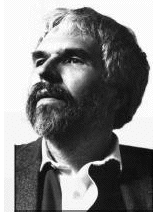|
Brakhage |
 |
|
by Grace McEvoy
Among the many worthwhile films screened in Austin at this year's SXSW film festival, one of the most intriguing was the documentary Brakhage (1998), directed by Jim Shedden. Through standard documentary devices such as interviews, home movies and pieces of Brakhages films, the life, ideas and creative output of a prolific and influential avant-garde filmmaker is revealed. Stan Brakhage has made over 200 films ranging in length from less than a minute to over four hours. Born in 1933, Brakhage studied photography at the Institute of Fine Art, San Francisco and made his first film, Interim, in 1952. Throughout his career, Brakhages self imposed challenge has been to make film that asks the viewer to see without preconceptions. In his book Metaphors on Vision, he wrote of an unprejudiced eye "which does not respond to the name of everything but which must know each object encountered in life through an adventure of perception" An obvious example of this "adventure" is the film Act of Seeing With One's Own Eyes (1971) which contains rhythmic and rich visuals of an autopsy that the viewer must see as purely visual in order to endure the gruesome content.
Brakhage's career spans over nearly 50 years and it is such a treat to see interviews of him as a young man bursting with creative energy. Ultimately the film reveals not only an artist, husband, father, teacher and friend but also chronicles the creative ebb and flow(mostly flow) of a man with a seemingly limitless supply of ideas and output despite the inevitable struggles with family and, as he ages, health. Heartening to those who have experienced the terror of lengthy creative blockages, one of the most charming segments of the film is a conversation between Brakhage and a friend about overcoming those blockages as well as the strains of middle age. Brakhage suffers the loss of most sight in one eye, depression, and bladder cancer yet manages to continue to be a productive artist. Ironically, the cancer may be the result of exposure to paint used to make some of his most beautiful films which have paint applied directly to the film base and look like moving abstract expressionist paintings.
Hardly at a loss for new ways to use film, Brakhage's interest in light and movement is purest in his surprisingly beautiful abstractions created by chipping emulsion off the film base. Most of his films are made without sound because Brakhage feels that the use of sound "cuts back sight." This use of silence is very effective especially in the examples from the Song series where the visual rhythms need no accompaniment. One may not even remember the films as silent because the visuals have a way of making the viewer create sound in his/her mind. Brakhages use of 8mm film format for many of his films elevates the home movie to high art and makes the art form more democratic as the tools for production are available to nearly anyone.
Jim Shedden's Brakhage is an excellent introduction to the mind of an artistic innovator, whose ideas are borrowed on a regular basis. Given his body of work and the influence that Stan Brakhage has had on the visual language of moving pictures, this film is an important document of the creative process of an artist, and as a bonus, Brakhage is a delightfully compelling subject himself. He tells a good story, can articulate his ideas well and is not too self conscious to burst out in song. By the films end the audience is excited about filmmaking and the prospect of seeing more of Brackages work.
For those interested in Stan Brakhage and experimental film there are more opportunities to see avant-garde film on the horizon here in Austin. The sound and visual artists collective, in*situ will be sponsoring a film series in September that will be curated by non other than Stan Brakhage. The Series will include films from Brakhage's personal collection and the plan is for Brakhage to come and introduce the series. Contingent upon funding, in*situ is also planning an event showing film of the late ethnomusicologist and avant-garde filmmaker Harry Smith who was a great influence on Stan Brakhage. Smith, well known for compiling the nations most influential collection of traditional music, the 1952 Folkways Anthology of American Folk Music, was given a lifetime achievement Grammy award in 1991 for that work. The showing of his film in the fall will be a must see event that will involve the use of lantern slides that give the film a 3-D effect. Check our events listings for locations and times for these screenings.
In*situ, under the directorship of Jon Ausbrooks, has been responsible for bringing and screening much of the experimental film seen in Austin since the groups inception five years ago. To date they have brought among others, internationally recognized film pioneers Kenneth Anger, Babbette Mangolte and Stan Brakhage. in*situ is sponsoring a presentation by minimalist filmmaker and musician Tony Conrad at 8p.m. on Saturday, March 27, 1999, at the Scottish Rite Temple Auditorium, 207 West 18th St. Conrad, an experimental filmmaker and a violinist will perform with cellist Alexandria Gelencser and screen his classic 1966 film The Flicker along with recent video works. Conrad emerged in the 1960s in New York working with artists such as John Cale and Lou Reed. Conrad is recognized as an important experimental filmmaker and The Flicker should prove to be an interesting experience as it has been known to induce audiences to perceive phantom colors, images and shapes. This will be a rare evening of performance and visual art. Admission is $12 in advance and $15 at the door. Tickets are available from Waterloo Records, 33 Degrees, Austix, and Vinal Edge Records in Houston.
|
||
top | this issue | ADA home |
||
